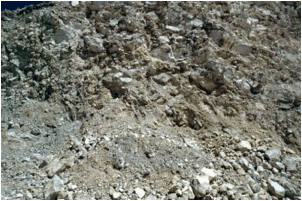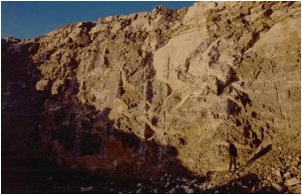The term “monomict movement breccia” has been introduced by Reiff (1978) by discussing monomictic breccia complexes in the Steinheim, Ries, Sierra Madera, Flynn Creek, Decaturville and Wells Creek impact structures. Related textures are grit brecciation and mortar texture (Hüttner 1969). In each case, a drastic brecciation of whole rock complexes with resulting grain sizes down to sand and silt fraction and frequently preserved fitting of the fragments is observed. This peculiar brecciation requires intense movement under very high confining pressure. In the impact structures referred to above, these movement breccias occur in excavated/ejected megablocks, in the crater floor, in inner rings and central uplifts. Reiff (1978) points to the fact that the typical texture of monomictic movement breccias is also observed in breccias from giant rock falls (for example the 1,500 m Flims, Switzerland, rock fall) and may in rare instances occur along tectonic fault zones. The occurrence of monomictic movement breccias in environments lacking tectonic fault zones and gradients sufficient for mass rock falls are strong clues to impact cratering events (Reiff 1978).
In the Rubielos de la Cérida impact basin, monomictic movement breccias are abundantly observed. In many cases, quarries are set up in these materials because the strongly fractures rocks make exploitation easier.
Monomictic movement breccias near Olalla

 Fig. 1. Large complexes of monomictic movement breccia (mylonite: W. Monninger, 1973; photo: Monninger), Paleozoic near Olalla.
Fig. 1. Large complexes of monomictic movement breccia (mylonite: W. Monninger, 1973; photo: Monninger), Paleozoic near Olalla.

 Fig. 2. Extensive monomictic movement breccia; Muschelkalk limestones and dolostones near Olalla.
Fig. 2. Extensive monomictic movement breccia; Muschelkalk limestones and dolostones near Olalla.
 Fig. 3. Monomictic movement breccia near Olalla: grit-brecciated Muschelkalk limestone exhibiting a peculiar slickenside.
Fig. 3. Monomictic movement breccia near Olalla: grit-brecciated Muschelkalk limestone exhibiting a peculiar slickenside.
 Fig. 4. Monomictic movement breccia near Olalla: mortar texture in Muschelkalk limestone.
Fig. 4. Monomictic movement breccia near Olalla: mortar texture in Muschelkalk limestone.
Monomictic movement breccia in the central-uplift chain between Bueña and Caminreal.

 Fig. 5. Monomictic movement breccia in the limestone quarry ahead of Bueña. The low-density, highly porous white carbonate material is assumed to have undergone decarbonization and recombination, or to be relics of carbonate melt from shock or frictional heating.
Fig. 5. Monomictic movement breccia in the limestone quarry ahead of Bueña. The low-density, highly porous white carbonate material is assumed to have undergone decarbonization and recombination, or to be relics of carbonate melt from shock or frictional heating.
Monomictic movement breccia in the southern central-uplift chain near Concud.

 Fig. 6. Monomictic movement breccia displaying grit brecciation and mortar texture.
Fig. 6. Monomictic movement breccia displaying grit brecciation and mortar texture.
Monomictic movement breccia in the southeastern rim zone. Limestone quarry near Corbalán.

 Fig. 7. Large limestone quarry near Corbalán: monomictic movement breccia extensive over hundreds of meters.
Fig. 7. Large limestone quarry near Corbalán: monomictic movement breccia extensive over hundreds of meters.
 Fig. 8. Exposed wall of the limestone quarry. The originally well developed bedding of the Jurassic limestones can only be guessed at. The white material is assumed to have undergone decarbonization and recombination, or to be relics of carbonate melt from shock or frictional heating.
Fig. 8. Exposed wall of the limestone quarry. The originally well developed bedding of the Jurassic limestones can only be guessed at. The white material is assumed to have undergone decarbonization and recombination, or to be relics of carbonate melt from shock or frictional heating.
 Fig. 9. The completely disintegrated limestone beds.
Fig. 9. The completely disintegrated limestone beds.
Monomictic movement breccia in the large quarry near Villafranca del Campo in the western impact basin.

 Fig. 10. Monomictic movement breccia in the large limestone quarry near Villafranca del Campo displaying grit brecciation and mortar texture. The light areas cutting all over the rock are faces exhibiting slickensides and polish. A few years ago, exploitation has removed the impressive wall. A visit to the quarry is still to be recommended.
Fig. 10. Monomictic movement breccia in the large limestone quarry near Villafranca del Campo displaying grit brecciation and mortar texture. The light areas cutting all over the rock are faces exhibiting slickensides and polish. A few years ago, exploitation has removed the impressive wall. A visit to the quarry is still to be recommended.






































































